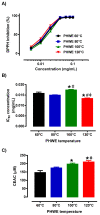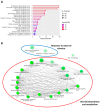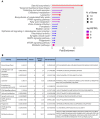Pressurized Hot Water Extraction of Mangosteen Pericarp and Its Associated Molecular Signatures in Endothelial Cells
- PMID: 38001785
- PMCID: PMC10669822
- DOI: 10.3390/antiox12111932
Pressurized Hot Water Extraction of Mangosteen Pericarp and Its Associated Molecular Signatures in Endothelial Cells
Abstract
The mangosteen (Garcinia mangostana L.) pericarp is known to be rich in potent bioactive phytochemical compounds such as xanthones, which possess pharmacologically important antioxidant activity and beneficial cardiometabolic properties. Mangosteen pericarp is typically classified as unavoidable food waste and discarded, despite being rich in bioactive phytochemical compounds that therefore present an exciting opportunity for valorization. Thus, this study aims to extract phytochemical compounds from mangosteen pericarp using pressurized hot water extraction (PHWE) and determine its biological effects in endothelial cells using RNA sequencing. Liquid chromatography with MS/MS (LC/MSMS) and UV detection (LC/UV) was subsequently used to identify three key phytochemical compounds extracted from the mangosteen pericarp: α-Mangostin, γ-Mangostin, and Gartanin. Within the tested range of extraction temperatures by PHWE, our results demonstrated that an extraction temperature of 120 °C yielded the highest concentrations of α-Mangostin, γ-Mangostin, and Gartanin with a concomitant improvement in antioxidant capacity compared to other extraction temperatures. Using global transcriptomic profiling and bioinformatic analysis, the treatment of endothelial cells with mangosteen pericarp extracts (120 °C PHWE) for 48 h caused 408 genes to be differentially expressed. Furthermore, our results demonstrated that key biological processes related to "steroid biosynthesis and metabolism", likely involving the activation of the AMPK signaling pathway, were upregulated by mangosteen pericarp extract treatment. In conclusion, our study suggests a green extraction method to valorize phytochemical compounds from mangosteen pericarp as a natural product with potential beneficial effects on cardiometabolic health.
Keywords: PHWE; antioxidant; food waste; green extraction; mangosteen pericarp; sustainability.
Conflict of interest statement
The authors have no conflicts of interest to declare that are relevant to the content of this article.
Figures






Similar articles
-
Alpha-Mangostin-Rich Extracts from Mangosteen Pericarp: Optimization of Green Extraction Protocol and Evaluation of Biological Activity.Molecules. 2018 Jul 25;23(8):1852. doi: 10.3390/molecules23081852. Molecules. 2018. PMID: 30044450 Free PMC article.
-
The purple mangosteen (Garcinia mangostana): Defining the anticancer potential of selected xanthones.Pharmacol Res. 2022 Jan;175:106032. doi: 10.1016/j.phrs.2021.106032. Epub 2021 Dec 9. Pharmacol Res. 2022. PMID: 34896543 Free PMC article. Review.
-
Mangosteen Pericarp Processing Technology to Create Economic Value and Reduce Biowaste.Foods. 2024 Jul 20;13(14):2286. doi: 10.3390/foods13142286. Foods. 2024. PMID: 39063370 Free PMC article.
-
Distribution of major xanthones in the pericarp, aril, and yellow gum of mangosteen (Garcinia mangostana linn.) fruit and their contribution to antioxidative activity.Biosci Biotechnol Biochem. 2013;77(5):984-7. doi: 10.1271/bbb.120931. Epub 2013 May 7. Biosci Biotechnol Biochem. 2013. PMID: 23649258
-
A Review of the Influence of Various Extraction Techniques and the Biological Effects of the Xanthones from Mangosteen (Garcinia mangostana L.) Pericarps.Molecules. 2022 Dec 10;27(24):8775. doi: 10.3390/molecules27248775. Molecules. 2022. PMID: 36557908 Free PMC article. Review.
Cited by
-
Metformin attenuates endoplasmic reticulum stress in diabetic kidney disease: mechanistic insights and future perspectives.Int Urol Nephrol. 2025 May 9. doi: 10.1007/s11255-025-04562-7. Online ahead of print. Int Urol Nephrol. 2025. PMID: 40343634 Review.
-
New Strategies for the Extraction of Antioxidants from Fruits and Their By-Products: A Systematic Review.Plants (Basel). 2025 Mar 1;14(5):755. doi: 10.3390/plants14050755. Plants (Basel). 2025. PMID: 40094704 Free PMC article. Review.
-
Current Therapeutic Landscape for Metabolic Dysfunction-Associated Steatohepatitis.Int J Mol Sci. 2025 Feb 19;26(4):1778. doi: 10.3390/ijms26041778. Int J Mol Sci. 2025. PMID: 40004240 Free PMC article. Review.
-
The c.119-123dup5bp mutation in human γC-crystallin destabilizes the protein and activates the unfolded protein response to cause highly variable cataracts.Sci Rep. 2025 Feb 24;15(1):6542. doi: 10.1038/s41598-025-90977-2. Sci Rep. 2025. PMID: 39994382 Free PMC article.
References
-
- Ovalle-Magallanes B., Eugenio-Pérez D., Pedraza-Chaverri J. Medicinal properties of mangosteen (Garcinia mangostana L.): A comprehensive update. Food Chem. Toxicol. 2017;109:102–122. - PubMed
Grants and funding
LinkOut - more resources
Full Text Sources

